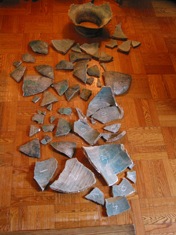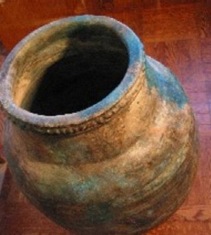Collecting and Restoring Pottery
Anyone who has an appreciation for art, craft and culture has at least several pieces of pottery or porcelain / china that he or she has acquired during travels to foreign lands or trips to local antiques stores. Some have inherited pottery vases, bowls or plates from their parents or favorite aunt or uncle. Often, the pieces that have been collected, sold, or passed on from generation to generation are affected by wear and tear and/or serious damage.
Fortunately there are pottery and porcelain repair and restoration experts such as Luba Sokolina at Luel Restoration Studio who specialize in flawless, invisible pottery, ceramic, porcelain, majolica, clay and terra cotta restoration. Before we talk about the history of pottery production, please note that if a piece of pottery or ceramic that you own is rare or collectible or has great sentimental value, DO NOT attempt to glue it or in any way fix it yourself. Not only will the porcelain and ceramic restoration expert charge you more for the work because it involves ungluing the pieces and preparing them for a new restoration, but also because you may seriously damage your pottery item by attempting to glue or clean the broken pieces yourself.
What is Pottery?
According to a Artistic Tile and Stone, a website that provides lots of information on pottery and ceramics, “Pottery comprises three distinctive types of wares. The first type, earthenware, has been made following virtually the same techniques since ancient times; only in the modern era has mass production brought changes in materials and methods. Earthenware is basically composed of clay–often blended clays–and baked hard, the degree of hardness depending on the intensity of the heat. After the invention of glazing, earthenwares were coated with glaze to render them waterproof; sometimes glaze was applied decoratively. It was found that, when fired at great heat, the clay body became nonporous. This second type of pottery, called stoneware, came to be preferred for domestic use. The third type of pottery is a Chinese invention that appeared when feldspathic material in a fusible state was incorporated in a stoneware composition. The ancient Chinese called kaolin (meaning “high place,” where it was originally found); this substance is known in the West as china clay. Petuntse, or china stone, a less decayed, more fusible feldspathic material, was also used in Chinese porcelain; it forms a white cement that binds together the particles of less fusible kaolin. Significantly, the Chinese have never felt that high-quality porcelain must be either translucent or white. Two types of porcelain evolved: “true” porcelain, consisting of a kaolin hard-paste body, extremely glassy and smooth, produced by high temperature firing, and soft porcelain, invariably translucent and lead glazed, produced from a composition of ground glass and other ingredients including white clay and fired at a low temperature. The latter was widely produced by 18th-century European potters.”


Below is an informative essay written by Miranda Nixon. Below the essay are some tips on how to repair pottery and porcelain items if you absolutely must do it yourself.
Pottery as Written Record
by Miranda Nixon
The production of pottery began approximately ten thousand years ago by civilizations in what is now Japan. They began with a primitive type of earthenware made of clay which was baked hard by heat. Potters in China , Egypt , Iran , and many other Eastern areas soon followed suit and many decorative types of pottery developed. Many decorating techniques, such as impressing, incising, and sgraffito (or scratched), were used to create elaborate colorful designs, in particular by the Chinese.
After the creation of such techniques, many cultures began utilizing this skill to transform pottery into a form of written record, capable of communicating knowledge, telling histories, and preserving their culture for future generations. Two such cultures that employed pottery as a writing surface were the Ancient Egyptians and the Mayans of Latin America . During the Pharaonic, Ptolemic, and Roman eras of Egyptian culture, everyday pieces of pottery were used by the poor who could not afford to purchase papyrus. Despite the inability to write long texts or paint large scenes, they were used for official documents, short stories, poems, letters, and even medical and commercial documents. In addition, the writing on pottery could be easily wiped off before allowed to dry permanently. This ability to reuse the surface allowed children to practice writing on them at school. The surviving pieces of pottery with personal and official writings provide a great deal of information concerning the lives of Ancient Egypt’s poor.
The Mayan civilization in Central America also utilized the painting and incising techniques to create narrative designs particularly in the Classic Period (325 A.D. – 925 A.D.). Rituals, ballgames, and even death scenes graced the outside of the wares of the elite. Converse to the Egyptian culture, the poor could only afford the simply decorated vessels that were chiefly used for storage (Wikipedia, the free encyclopedia 2007) . The vases made especially for the funerals of the elite were particularly elaborate. Most ware found in these ancient tombs are depicted with various scenes and codices that explain the birth of their world and other important events (such as the life history of the deceased ruler), as well as images of their gods and underworld figures.
The preservation of these important artifacts (or potsherds) can be extremely difficult depending on how the object has been handled over the years and where and in what conditions it has been stored. Pottery is one of the most durable artifacts for a couple of reasons: only simple care is required, and sensitivity to humidity, light, and temperature is low (Canadian Conservation Institute 2002) . These relics can survive for thousands of years, as archaeologists can attest to. The storage of pottery can be a cause for concern because, as three-dimensional objects, they can take up a good deal of space. Many artifacts may have survived for hundreds of years, but could be placed in inadequate storage because an object that is thousands of years old may take precedence. Therefore, their ability to survive can also be a problem. Additionally, there are several types of damage and behavior that will cause the ornamented pottery to degrade at a much quicker rate.
The most common type of damage that pottery can experience is breakage. Because they are hard and brittle, poor storage arrangements and mishandling can cause them to crack or break quite easily. Stains, scratches, and the wearing off of paint also cause the artifact to degrade quicker. These can be caused by the environmental conditions the object is stored in, its display, or how it was improperly cleaned, repaired, or used. Another possible harmful condition that can cause breakage is when salts present in soil have been absorbed by the buried artifact. The salts will expand when the humidity levels are high and can lead to cracking. Finally, old repairs and restorations that have not been completed by a professional can lead to further degradation instead of preservation. Both the materials used and the handiwork of the repair can cause stains and breakage which will weaken the overall construction.
Nevertheless, steps can be taken to preserve these artifacts before they can no longer serve as written record. As long as one is cautious concerning pottery’s storage and environment, its handling, and its repairs and cleaning process, the survival of the item for another few hundred years will be insured. When storing these artifacts, it is important to maintain a stable environment (a temperature between 65 and 70 degrees Fahrenheit and relative humidity at 45%). High moisture can cause cracks from salt absorption (explained above) and high heat can cause stains to darken (Deck 2007) . The American Institute for Conservation of Historic and Artistic Works outlines the best way to safely store this informational pottery:
[They] should be stored and displayed on sturdy, level surfaces that are secure from bumps and jarring. Objects should be covered or enclosed to protect them from dirt and dust. Pieces can also be wrapped in acid-free, lignin-free tissue and stored in acid-free cardboard boxes…Any box used for storage should be strong enough to support the weight of the objects and should have a secure bottom. The container should also be large enough to enclose the entire object. Objects should not be allowed to bump or fall against each other.
Lastly, it is important to ensure that no food or metals are in contact with the artifact being stored because they can cause stains and corrosion. Another step in the preservation process is the handling of the object. It is important to overestimate the fragility of pottery; this caution can prevent unexpected damage that may be difficult to repair. Prior to physically handling the item, hands should be washed but gloves should not be donned due to their slippery texture. Both hands should always be used to lift an object, but it should never be held by any projections. They may not be attached as securely as they seem (Canadian Conservation Institute 2002) . Also be careful not to rub the ornamental decorations since it could easily wear off (Deck 2007) . Make sure that a cleared space that is large enough to accommodate the artifact is available and that there is ample room to move your way over to that space. For longer distances, it is better to carry the object in a padded basket or box. If the object is to be displayed in an area that is subjected to continuous underground vibrations, it may be wise to secure it with very tiny dots of wax. This could, however, damage the item so a conservator should be consulted first.
Finally, repair and restoration of pottery – ceramic, porcelain, stoneware — are not only ways in which the artifact can degrade but also ways in which it can be preserved if done correctly. For ancient pottery, it is important that a conservator carries out the cleaning and repairs. If the proper cleaning agents and/or adhesives are not used, they can cause stains and the flaking of paint.
TIPS ON HOW TO REPAIR BROKEN POTTERY AND PORCELAIN ITEMS… if you must do it yourself or can’t afford a professional restoration expert.
The first step in repairing a broken piece of china, porcelain, pottery, or ceramic is to clean every piece thoroughly with dishwashing liquid and an old toothbrush.
The best adhesive for bonding china is slow-setting epoxy-resin. Apply it as thinly as possible to one side of the join only.
Support and tape the piece or pieces while the adhesive hardens. Lay many small pieces of cellophane tape, evenly spaced across the entire length of the join, while using firm, even pressure to push the pieces together.
Remove the tape after 24 hours. Use acetone to wipe off tape stains and a sharp knife for excess dried adhesive.
To repair chipped pottery, first fill in chips using a putty of epoxy-resin as a base, with titanium dioxide – a strong white pigment – for color, and kaolin powder as a filler. Do not inhale kaolin powder.
Add kaolin until the putty is fairly stiff; then transfer some to the chip with a small metal spatula or orange stick, pressing it in. Use a wet finger to pat it into shape. Always underfill rather than overfill.
After a few hours but before the filler is rock hard, rub it down with small cut-up squares of sandpaper, starting with a coarse, a medium, then a fine grade.
For more elaborate modeling, such as a cup handle, follow the same procedure but make sure the filler is really stiff with kaolin powder and left for two or three hours to harden before modeling to the required shape.
To obtain a closer match to the background color than plain white, buy a range of fine-ground dry artist’s pigments from a good art shop and add to the filler.
For any decoration, mix dry pigments with a varnish medium in a metal or china eggcup or small glass jar. Enamel paints from model shops are a convenient but less versatile alternative to dry pigments. When paint is dry, cover with a clear varnish.
Please note that it always costs more to professionally restore something that had been previously glued or repaired.
DO NOT REPAIR OR RESTORE ANYTHING TOO VALUABLE OR ANCIENT. Find a ceramic and porcelain professional restorer and let him or her do the job for you.
Luel Restoration Studio
646-251-5593
References are available upon request.




